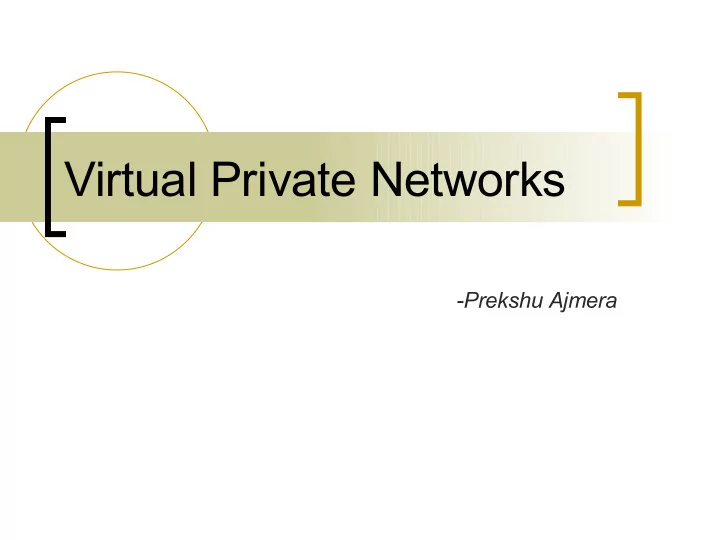

Virtual Private Networks -Prekshu Ajmera
Virtual Private Network Internet runs on public lines that are insecure Need to communicate securely Private lines : costly option VPN Secure private communications over public internet Private IP packets encapsulated within public packets (tunnel)
VPN where and why?
Types of VPN Secure VPNs uses public lines encryption / authentication methods IPsec, SSL Trusted VPNs service provider's private network SLA to ensure QoS. MPLS, L2VPN, L3VPN
IPsec IPsec -standardized framework for securing IP communications Modes Tunnel / Transport Protocols AH - authentication, IP header integrity ESP - data confidentiality, integrity, authentication.
IPsec IPsec -standardized framework for securing IP communications Modes Tunnel / Transport Protocols AH - authentication, IP header integrity ESP - data confidentiality, integrity, authentication.
IPsec
#!/usr/sbin/setkey -f # on 10.2.1.90 # AH add 10.2.0.85 10.2.1.90 ah 15700 -A hmac-md5 "1234567890123456"; add 10.2.1.90 10.2.0.85 ah 24500 -A hmac-md5 "1234567890123456"; # ESP add 10.2.0.85 10.2.1.90 esp 15701 -E 3des-cbc " 123456789012123456789012 "; add 10.2.1.90 10.2.0.85 esp 24501 -E 3des-cbc " 123456789012123456789012 "; spdadd 10.2.1.90 10.2.0.85 any -P out ipsec esp/transport//require ah/transport//require; spdadd 10.2.0.85 10.2.1.90 any -P in ipsec esp/transport//require ah/transport//require;
Tunnel vs Transport Transport s ecure an end-to-end connection between two systems only payload encrypted Tunnel Encapsulation of original IP packet in another packet between gateways (routers, firewalls) End systems need not support this
SSL provides privacy using cryptography. end point authentication, typically - server – certificates client – passwords runs on layer beneath application layer protocols such as https, sftp, smtp
Comparison of IPSec & SSL
Comparisons... IPSec resides in the IP layer, SSL in the Application layer. The advantage of IPsec - elimination of overhead caused by each channel. SSL is one connection per one session type Disadvantage of ipsec - what if key was compromised. IPSec keys are exchanged over UDP (port 500 only).
Comparisons... SSL clients are not bound to a specific port as opposed to IPsec. IPsec suffers NAT traversal problem. NAT changes the source IP address, which is authenticated by AH.
Comparisons... IPsec doesn't integrate well among vendors. SSL is trouble free. IPsec has a high overhead in terms of header size(64 bytes, esp,ah tunnel mode) compared to SSL(21 bytes) SSL doesnt work with UDP, whereas IPsec avoids UDP problem by adding an IPsec header to the original packet's field
Conclusions... IPSec SSL Configuration hard easy Client Authentication must optional Pre-Shared Key yes no yes no Interoperability Problem TCP Support all some UDP Support yes no Compression Support yes OpenSSL only HandShake Time slow fast
Trusted VPNs Do not use cryptographic tunnelling Rely on single provider’s network to protect the traffic. Thus QoS comes into picture. Classified by OSI layer at which access network operates Layer3VPN • IP Service, Routing relationship between PE and CE Layer2VPN • Data link service, Ethernet MAC
Basic Structure Data arrives from CE via access network Encapsulated by PE & sent over tunnel Decapsulated by receiving PE & sent over access network to CE
Layer2 VPNs L2VPN forwards customer packets based on layer-2 (MAC address) information. Types •VPWS •VPLS
Layer3 VPNs L3VPN works on network layer. Two Headers Tunnel Label VPN Label
MPLS MPLS-over-L2TPv3 encapsulation Not necessary for whole IP backbone to be MPLS compatible
VPN Toplogies The topology for a VPN consists of a set of nodes interconnected via tunnels. Types : Full Mesh - tunnel exists between every pair of VPN edge devices.(Fig 1) Hub and Spoke - single-spoke connectivity to a hub router at a central facility. (Fig 2) Fig1 Fig2
VPN Toplogies (cont..) Using Partial Mesh : reduce the number of tunnels to force traffic through a firewall, or for monitoring or accounting purposes.
Disadvantages Potential pitfalls in the VPN model VPNs require an in-depth understanding of public network security issues. VPN technologies from different vendors may not work well together. Can expose a company to potential security risks. Scalability issues.
References C. Metz, “The Latest in Virtual Private Networks: Part I,”IEEE - 2003 C. Metz, “The Latest in Virtual Private Networks: Part II,”IEEE - 2004 B. Daugherty and C. Metz, “Multiprotocol Label Switching and IP,” IEEE - 2005 A. Alshamsi, T Saito, “A Technical Comparison of SSL and IPsec,” IEEE – 2004 http://www.ipsec-howto.org/ipsec-howto.pdf
Thanks ?
Recommend
More recommend